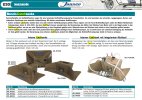Things to consider..
Quote Pegasus racing: Fuel cell foam reduces fuel sloshing and minimizing the chance of explosions, but it does deteriorate over time. As the foam breaks down, it can quickly clog fuel filters, fuel pumps, and carburetors. We recommend replacing fuel cell foam baffling at least every three years.
Second, modern fuels contain % ethanol (at least in Europe). Not every foam can handle that.
I had my Alloy tanks custom made at a local welding shop with baffles.
Quote Pegasus racing: Fuel cell foam reduces fuel sloshing and minimizing the chance of explosions, but it does deteriorate over time. As the foam breaks down, it can quickly clog fuel filters, fuel pumps, and carburetors. We recommend replacing fuel cell foam baffling at least every three years.
Second, modern fuels contain % ethanol (at least in Europe). Not every foam can handle that.
I had my Alloy tanks custom made at a local welding shop with baffles.


